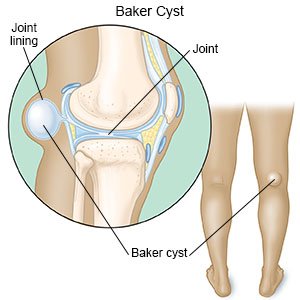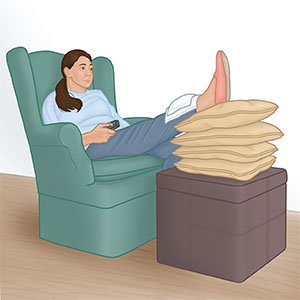Baker Cyst
Medically reviewed by Drugs.com. Last updated on Apr 6, 2025.
A Baker cyst is a bulging lump of fluid behind your knee. A Baker cyst can develop if you have a knee injury, or a condition such as osteoarthritis or a connective tissue disorder. A Baker cyst may also be called a popliteal cyst.
 |
DISCHARGE INSTRUCTIONS:
Return to the emergency department if:
- You have severe pain.
- You have bruising on the ankle below the cyst.
- Your calf turns blue below the cyst.
- Your calf or knee is swollen or bleeding.
Call your doctor if:
- You have a fever.
- Your pain does not improve with medicine.
- You have questions or concerns about your condition or care.
Medicines:
- NSAIDs , such as ibuprofen, help decrease swelling, pain, and fever. NSAIDs can cause stomach bleeding or kidney problems in certain people. If you take blood thinner medicine, always ask your healthcare provider if NSAIDs are safe for you. Always read the medicine label and follow directions.
- Take your medicine as directed. Contact your healthcare provider if you think your medicine is not helping or if you have side effects. Tell your provider if you are allergic to any medicine. Keep a list of the medicines, vitamins, and herbs you take. Include the amounts, and when and why you take them. Bring the list or the pill bottles to follow-up visits. Carry your medicine list with you in case of an emergency.
Care for your knee:
- Rest as needed. Limit movement as your knee heals. This will help decrease the risk of more damage to your knee. You may need crutches to take weight off your injured knee. Use crutches as directed.
- Ice your knee. Ice helps decrease swelling and pain. Use an ice pack, or put ice in a plastic bag. Cover it with a towel before you place it on your skin. Ice your knee for 15 to 20 minutes, 3 to 4 times each day. Do this for 2 to 3 days.
- Support your knee. Wrap your knee with an elastic bandage. Ask your healthcare provider if you need a brace for more support. This will help decrease swelling and movement so your knee can heal.
- Elevate your knee. Use pillows to raise your knee above the level of your heart as often as you can. This will help decrease swelling. Do not put the pillow directly under your knee. Put it under your calf instead.

- Go to physical therapy as directed. A physical therapist teaches you exercises to help improve movement and strength, and to decrease pain.
Follow up with your doctor as directed:
Write down your questions so you remember to ask them during your visits.
© Copyright Merative 2025 Information is for End User's use only and may not be sold, redistributed or otherwise used for commercial purposes.
The above information is an educational aid only. It is not intended as medical advice for individual conditions or treatments. Talk to your doctor, nurse or pharmacist before following any medical regimen to see if it is safe and effective for you.
Further information
Always consult your healthcare provider to ensure the information displayed on this page applies to your personal circumstances.
